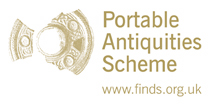File:A complete lead trade weight of medieval to post-medieval date (FindID 877257).jpg

Original file (7,644 × 4,721 pixels, file size: 4.43 MB, MIME type: image/jpeg)
Captions
Captions
Summary
[edit]| A complete lead trade weight of medieval to post-medieval date | |||
|---|---|---|---|
| Photographer |
The Portable Antiquities Scheme, Phil Hughes, 2017-12-01 15:23:48 |
||
| Title |
A complete lead trade weight of medieval to post-medieval date |
||
| Description |
English: A complete lead trade weight of medieval to post-medieval date. The weight is shield shaped with a circular perforation through the pointed edge. A moulded relief design of three lions rampant left is present on the upper surface. The reverse is flat and undecorated.
The metal has a light white patina and is worn. The weight is 58.0 mm long, 46.7 mm wide, 0.8 mm thick and weighs 123.08 g. With a mass of 123.08g (4.34 oz imperial) this was probably intended to be an 5 oz (141.75) weight in the avoirdupois system with 16oz in the pound. Lead weights have been used in trade since the Roman period and were used for weighing quantities of coin as well as goods. Shield-shaped weights are a distinctive group of trade weights which are used from c.AD 1380 and continue into the 15th century. Biggs & Withers (2000, p.34) discuss the difficulties in dating shield weights as links between documentary evidence and artefactual evidence are difficult to establish. Their longevity coupled with various qualities of workmanship and numerous designs employed over a long period of time also make dating difficult. It is likely however that some belong to the period following the conversion of the trade pound under the averdepois system and as such it is likely that these weights represent a desire to standardize the trade weight system. |
||
| Depicted place | (County of findspot) Lincolnshire | ||
| Date |
between 1380 and 1600 date QS:P571,+1500-00-00T00:00:00Z/6,P1319,+1380-00-00T00:00:00Z/9,P1326,+1600-00-00T00:00:00Z/9 |
||
| Accession number |
FindID: 877257 Old ref: DENO-C367EE Filename: DENOC367EE.jpg |
||
| Credit line |
|
||
| Source |
https://finds.org.uk/database/ajax/download/id/639682 Catalog: https://finds.org.uk/database/images/image/id/639682/recordtype/artefacts archive copy at the Wayback Machine Artefact: https://finds.org.uk/database/artefacts/record/id/877257 |
||
| Permission (Reusing this file) |
Attribution License | ||
Licensing
[edit]- You are free:
- to share – to copy, distribute and transmit the work
- to remix – to adapt the work
- Under the following conditions:
- attribution – You must give appropriate credit, provide a link to the license, and indicate if changes were made. You may do so in any reasonable manner, but not in any way that suggests the licensor endorses you or your use.
File history
Click on a date/time to view the file as it appeared at that time.
| Date/Time | Thumbnail | Dimensions | User | Comment | |
|---|---|---|---|---|---|
| current | 13:23, 6 December 2018 |  | 7,644 × 4,721 (4.43 MB) | Fæ (talk | contribs) | Portable Antiquities Scheme, DENO, FindID: 877257, medieval, page 525, batch count 9149 |
You cannot overwrite this file.
File usage on Commons
The following page uses this file:
Metadata
This file contains additional information such as Exif metadata which may have been added by the digital camera, scanner, or software program used to create or digitize it. If the file has been modified from its original state, some details such as the timestamp may not fully reflect those of the original file. The timestamp is only as accurate as the clock in the camera, and it may be completely wrong.
| Orientation | Normal |
|---|---|
| Horizontal resolution | 600 dpi |
| Vertical resolution | 600 dpi |
| Software used | Adobe Photoshop Elements 11.0 Windows |
| File change date and time | 12:16, 30 November 2017 |
| Color space | sRGB |
| Date metadata was last modified | 12:16, 30 November 2017 |
| Date and time of digitizing | 11:16, 24 November 2016 |
| Unique ID of original document | xmp.did:FC1CE1266E84E511A67B812D55357F06 |
| IIM version | 19,923 |
